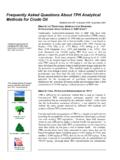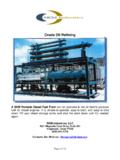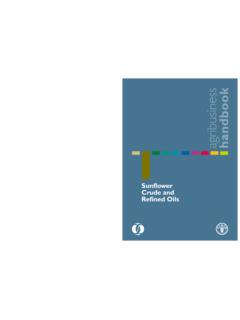Transcription of Refining Crude Oil: History, Process and Products
1 Refining Crude Oil: history , Process and Products Nearly every aspect of our modern lifestyle is impacted by oil. Oil is used to power our vehicles, to create medicines that keep us healthy, and to make the plastics, cosmetics, and other personal Products that enhance our daily lives. However, none of these Products would exist without the Refining Process . For example, you wouldn t put Crude oil in the gas tank of your car! It has to be refined into gasoline first! Today, Crude oil is refined all over the world. The largest oil refinery is the Paraguana Refining Complex in Venezuela, which can Process 940,000 barrels of oil each day. In fact, most of the oil industry s largest refineries are in Asia and South America. Nevertheless, the practice of Refining oil was created in the United States, where it continues to be an important part of the nation s economy. history Samuel M. Kier, a native of southwestern Pennsylvania, was the first person to refine Crude oil.
2 In the mid-1840s, he became aware of Crude oil through his salt business. Occasionally, wells drilled for salt water would produce foul-smelling petroleum alongside the brine. For many in the salt business, the oil was a nuisance, and they were content to burn it or allow it to run off into nearby waterways. However, Kier was an entrepreneur, and he believed that he could turn the oily by- product of his salt wells into something of value. Kier first used the flammable oil produced by his salt wells to light his salt works at night. The burning Crude produced an awful smell and a great deal of smoke. Nevertheless, Kier was able to light his business without paying for an expensive illuminant like whale oil. Next, Kier packaged pure Crude oil in half-pint bottles for sale as a medicine. A bottle of Kier s Petroleum sold for 50 cents. Kier employed a workforce of salesmen who traveled the countryside in colorful wagons advertising and marketing his medicinal product .
3 Later, he sold Kier s Petroleum exclusively through drug stores. However, by 1852, oil s medicinal fad had faded, and Kier needed another way to make his oil useful and valuable. Kier knew Crude oil would burn and thought that it could make a good and inexpensive lamp oil. However, the smell and smoke that burning oil produced made it hard to sell as an illuminant. In 1849, Kier took samples of his Crude oil to Philadelphia where they were analyzed by Professor James C. Booth, a chemist. Booth agreed that Crude oil could be used for illumination, but that it needed to be distilled or refined to get the best burning fluid. Thus, in 1850, Kier started experimenting with distillation and became the first person in the to attempt to use liquid petroleum as a starting material to produce lamp oil. His Refining experiments were successful and by 1851, Kier produced a product called Carbon Oil, a fuel oil which burned with little smoke and odor.
4 He sold his Carbon Oil for $ a gallon. In partnership with John T. Kirkpatrick, Kier created the first petroleum refinery in Pittsburgh, Pennsylvania. He started with a small one or two-barrel still, but by 1854, he had a larger five-barrel still in operation. When Edwin L. Drake struck oil near Titusville, Pennsylvania in 1859, the market became flooded with oil, and Pittsburgh saw seven new oil refineries come into operation. By the end of the 1860s, there were 58 refineries operating in Pittsburgh alone. Samuel M. Kier spent a great deal of his life trying to make Crude oil useful and valuable and along the way he gave birth to the Refining industry. The Process of Refining Crude Oil In the early days of the oil industry, the methods for Refining oil were very different than the methods we use today. People like Samuel M. Kier used horizontal cylindrical stills that only held 5 to 6 barrels of oil at a time.
5 Using the stills, refiners were able to raise the temperature of the oil very slowly. As the temperature rose, they removed the distillates like gasoline for which they had no use, procuring only the lamp oil or kerosene. Over time, oil s other distillates became useful and the Refining Process evolved. Today, pipelines, railroads, tankers, and trucks transport Crude oil to refineries where it is transformed into the Products we use every day. Oil refineries seem like they would be dirty places, but most governments have placed restrictions on how refineries dispose of waste Products and what they can emit into the air. There are many environmental programs that have made oil Refining a safer, cleaner industry. Once it enters the modern refinery, Crude oil goes through a Process called fractional distillation. This Process separates the different components of Crude oil so that they can be further refined. Fractional distillation begins when the Crude oil, which is a mixture of different hydrocarbons, is put into a high-pressure steam boiler.
6 This is a tank that makes the oil boil and turn to vapor, much like boiling water turns into water vapor. The Crude oil is heated to temperatures up to 1112 Fahrenheit. After the oil becomes vapor, it enters the bottom of the distillation column through a pipe. The distillation column is a tall tank that contains many plates or trays. The vapor rises in the column, cooling as it rises. The specific vapors cool at their boiling points and condense on the plates or trays in the column. Much like water condensation on the outside of a cold glass, the vapors turn into liquid fractions as they condense. The liquid fractions flow through pipes and are collected in separate tanks. The fractions include gases, naphtha, gasoline, kerosene, diesel fuel, lubricating oils, heavy oils, and other materials. From here, the liquid fractions are transported to other areas of the refinery for further processing. Products from Petroleum The Products refined from the liquid fractions of Crude oil can be placed into ten main categories.
7 These main Products are further refined to create materials more common to everyday life. The ten main Products of petroleum are: Asphalt Asphalt is commonly used to make roads. It is a colloid of asphaltenes and maltenes that is separated from the other components of Crude oil by fractional distillation. Once asphalt is collected, it is processed in a de-asphalting unit, and then goes through a Process called blowing where it is reacted with oxygen to make it harden. Asphalt is usually stored and transported at around 300 Fahrenheit. Diesel Diesel is any fuel that can be used in a diesel engine. Diesel is produced by fractional distillation between 392 Fahrenheit and 662 Fahrenheit. Diesel has a higher density than gasoline and is simpler to refine from Crude oil. It is most commonly used in transportation. Fuel Oil Fuel oil is any liquid petroleum product that is burned in a furnace to generate heat. Fuel oil is also the heaviest commercial fuel that is produced from Crude oil.
8 The six classes of fuel oil are: distillate fuel oil, diesel fuel oil, light fuel oil, gasoil, residual fuel oil, and heavy fuel oil. Residual fuel oil and heavy fuel oil are known commonly as navy special fuel oil and bunker fuel; both of these are often called furnace fuel oil. Gasoline Almost half of all Crude oil refined in the United States is made into gasoline. It is mainly used as fuel in internal combustion engines, like the engines in cars. Gasoline is a mixture of paraffins, naphthenes, and olefins, although the specific ratios of these parts depends on the refinery where the Crude oil is processed. Gasoline refined beyond fractional distillation is often enhanced with iso-octane and ethanol so that it is usable in cars. Gasoline is called different things in different parts of the world. Some of these names are: petrol, petroleum spirit, gas, petrogasoline, and mogas. Kerosene Kerosene is collected through fractional distillation at temperatures between 302 Fahrenheit and 527 Fahrenheit.
9 It is a combustible liquid that is thin and clear. Kerosene is most commonly used as jet fuel and as heating fuel. In the early days of oil, kerosene replaced whale oil in lanterns. In the early 21st century, kerosene was used to power New York City Transit buses. Now, kerosene is used as fuel in portable stoves, kerosene space heaters, and in liquid pesticides. Liquefied Petroleum Gas Liquefied petroleum gas is a mixture of gases that are most often used in heating appliances, aerosol propellants, and refrigerants. Different kinds of liquefied petroleum gas, or LPG, are propane and butane. At normal atmospheric pressure, liquefied petroleum gas will evaporate, so it needs to be contained in pressurized steel bottles. Lubricating Oil Lubricating oils consist of base oils and additives. Mineral oils are manufactured by special processes called: solvent extraction, catalytic dewaxing, hydrocracking, and isohydromerization.
10 Different lubricating oils are classified as paraffinic, naphthenic, or aromatic. Lubricating oils are used between two surfaces to reduce friction and wear. The most commonly-known lubricating oil is motor oil, which protects moving parts inside an internal combustion engine. Paraffin Wax Paraffin wax is a white, odorless, tasteless, waxy solid at room temperature. The melting point of paraffin wax is between 117 Fahrenheit and 147 Fahrenheit, depending on other factors. It is an excellent electrical insulator, second only to Teflon , a specialized product of petroleum. Paraffin wax is used in drywall to insulate buildings. It is also an acceptable wax used to make candles for the Jewish Menorah. Bitumen Bitumen, commonly known as tar, is a thick, black, sticky material. Refined bitumen is the bottom fraction obtained by the fractional distillation of Crude oil. This means that the boiling point of bitumen is very high, so it does not rise in the distillation chamber.








